

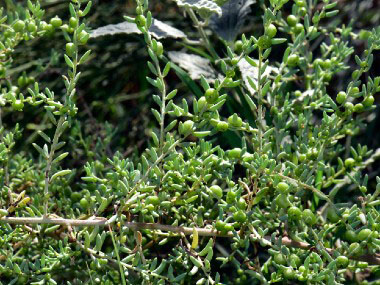

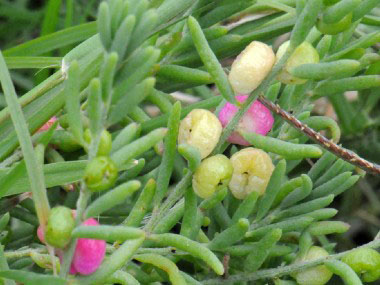
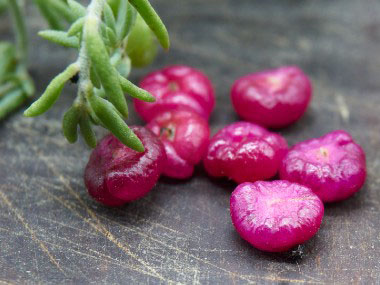
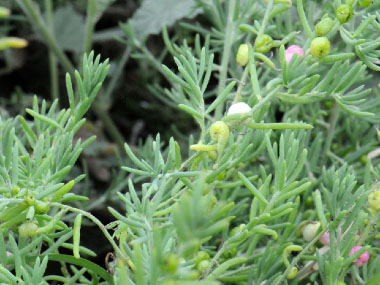
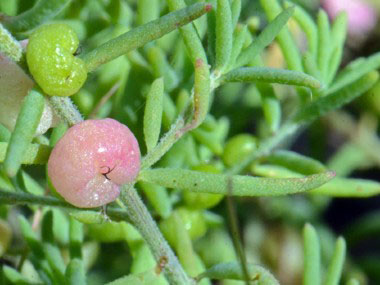
To support our efforts please browse our store (books with medicinal info, etc.).
A special thank you to Eugene P. Sturla of Southwest Desert Flora. His generosity of providing all images of this tree made this page possible.
Ruby Saltbush is a very hardy, evergreen shrub with fleshy green leaves that are covered in fine white hairs. This perennial shrub can tolerate a variety of soil and weather conditions. A healthy shrub will survive saline soil, sandy soil, long droughts and even some frost. Formerly, it was in the Chenopodioideae family, but is now in the Amaranthaceae (pigweed) family. It is native to Australia. Its resilience to harsh environments makes it valuable for landscaping in arid regions. Also, it has a deep root system which helps stabilize soil and prevent erosion, making it beneficial for soil conservation efforts.
Trunk/Bark
No trunk as this is a spreading shrub with branches.
Branches/Twigs
Spreading branches are woody, or semi-woody, with the leaves growing on a twig-like grow from the branches.
Height
On average this shrub grows 30 to 60cm (1 to 2') tall and wide. Within the protection of other vegetation, it can grow up to 1 m (3') la tall and wide.
Leaves/Needles
Succulent-like leaves range from dark blue-green to light shades of silver-grey and silver-green. The leaves often appear succulent and may be smooth or have whitish (tomentose) hairs. They grow alternate, are slender, round, and measure 6 to 15mm (.25 to .60") long. Stems are distinctively marked with parallel lines.
Flowers
Flowers are white or greenish, inconspicuous, solitary, and very small, measuring less than 3mm (.11") across. Flowers occur from axillary buds at bases of the leaves.
Fruit
This species produces small, edible berries that measure about 5 to 8mm (.19 to .31") in diameter. They range in colour from yellow to pink to (almost) red, although the pink to red berries are more desirable. It usually fruits in California and Arizona in autumn, May to September in Australia; however, this can fruit year-round under the right conditions.
Habitat
Ruby Saltbush thrives in coastal regions, saline environments, and areas with high soil salinity. In Arizona, it can be found in sandy, riparian or semi-wet areas. In Australia it is found from coastal areas, sand dunes, clay and saline depressions among other habitat types.
Edible Parts
Berries can be eaten raw and have a unique tangy flavor that can be incorporated into jams, sauces, and other culinary creations. They are rich in antioxidants and contain vitamin C. Leaves are also edible, but are rich in oxalates, they should be cooked before eating, or consumed sparingly. According to Specialty Produce; "Saltbush is an excellent source of protein and contains beneficial calcium and trace minerals. It also contains 20% less sodium than table salt and is a rich source of antioxidants.
Other Name
Barrier Saltbush.
Recipes
Winter Survival Food Handbook

PDF Plant Magazines
Types of Wild Food
Geographic Zones Seasons
Disclaimer
EdibleWildFood.com is informational in nature. While we strive to be 100% accurate, it is solely up to the reader to ensure proper plant identification. Some wild plants are poisonous or can have serious adverse health effects.
We are not health professionals, medical doctors, nor are we nutritionists. It is up to the reader to verify nutritional information and health benefits with qualified professionals for all edible plants listed in this web site. Please click here for more information.
Why Edible Wild Food?
- Food costs are rising
- Free, wild food is readily abundant
- Wild food adds nutrition to your diet
- Wild food can help treat various medical conditions





